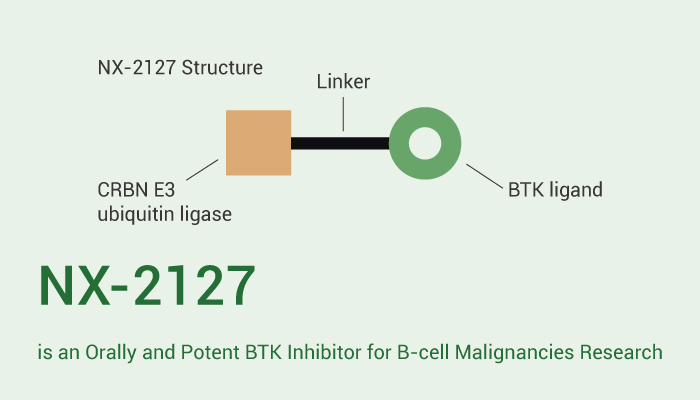BTK (Bruton’s tyrosine kinase), is a Tec family tyrosine kinase. It plays a crucial role in B cell development and function. BTK has dual regulatory functions in B cell apoptosis, such as promoting radiation-induced apoptosis but inhibiting Fas-activated apoptosis. BTK is a key target in B-cell malignancies such as chronic lymphocytic leukemia (CLL). The BTK mutation can also lead to X-linked hereditary immunodeficiency disease (X-linked agammaglobulinemia, XLA). XLA is a rare inherited immunodeficiency disorder that causes the body to fail to produce enough normal antibodies, making it susceptible to infection. BTK also stimulates regulatory T cells and natural killer T cells, inhibits IL-2 production and affects immune function. However, NX-2127 is a potent BTK inhibitor, which can degrade mutant BTK.
NX-2127 is an orally active BTK inhibitor with anti-tumor activity and immunomodulatory activity.

NX-2127 exerts a cellular degradation effect and degrades BTK in various tumor cells with IC50s ranging from 1 nM to 13 nM. It inactivates others covalent and noncovalent BTK inhibitors due to its high affinity with WT and mutant BTK. NX-2127 potently degrades C481S, T474I, V416L, and L528W-mutant BTK, to inhibit activation marker expression on cells. Moreover, it increases IL-2 production in primary human T cells and degrades IKZF1/3 due to immunomodulatory activity.
As for in vivo studies, NX-2127 shows robust tumor growth inhibition in mouse of WT TMD8 and C481S mutant xenograft models. NX-2127 (1 mg/kg; po; once daily for 14 days) shows potent degradation of BTK in cynomolgus monkeys. And it also leads to dose-proportional exposure in plasma and BTK degradation to <10% of baseline levels in circulating and splenic B cells. Finally, NX-2127 results in superior tumor growth inhibition (TGI) in both WT TMD8 and C481S mutant xenograft models in mouse.
Above all, NX-2127 is an orally active BTK inhibitor. Not only, it degrades BTK to inhibit tumor growth in vitro and in vivo, it regulates IL-2 level in T cells with immunomodulatory activity.
References:
[1] Robbins D W, et al. Blood, 2020, 136: 34.
[2] Mihalic J T, et al. Cancer Research, 2023, 83(7_Supplement): 3423-3423.